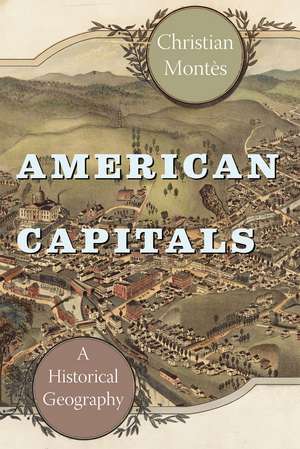American Capitals: A Historical Geography: University of Chicago Geography Research Papers
Autor Christian Montèsen Limba Engleză Hardback – 10 feb 2014
State capitals are an indelible part of the American psyche, spatial representations of state power and national identity. Learning them by heart is a rite of passage in grade school, a pedagogical exercise that emphasizes the importance of committing place-names to memory. But geographers have yet to analyze state capitals in any depth. In American Capitals, Christian Montès takes us on a well-researched journey across America—from Augusta to Sacramento, Albany to Baton Rouge—shedding light along the way on the historical circumstances that led to their appointment, their success or failure, and their evolution over time.
Preț: 372.87 lei
Preț vechi: 464.36 lei
-20% Nou
Puncte Express: 559
Preț estimativ în valută:
71.35€ • 74.69$ • 59.04£
71.35€ • 74.69$ • 59.04£
Carte indisponibilă temporar
Doresc să fiu notificat când acest titlu va fi disponibil:
Se trimite...
Preluare comenzi: 021 569.72.76
Specificații
ISBN-13: 9780226080482
ISBN-10: 022608048X
Pagini: 408
Ilustrații: 21 halftones, 6 line drawings, 42 tables
Dimensiuni: 152 x 229 x 28 mm
Greutate: 0.66 kg
Editura: University of Chicago Press
Colecția University of Chicago Press
Seria University of Chicago Geography Research Papers
ISBN-10: 022608048X
Pagini: 408
Ilustrații: 21 halftones, 6 line drawings, 42 tables
Dimensiuni: 152 x 229 x 28 mm
Greutate: 0.66 kg
Editura: University of Chicago Press
Colecția University of Chicago Press
Seria University of Chicago Geography Research Papers
Notă biografică
Christian Montès is professor of geography at the Université Lumière Lyon 2 and the author of L’Amérique du Nord: Les Etats-Unis and Les transports dans l’aménagement urbain à Lyon. He lives in Lyon, France.
Cuprins
1 Capitals: A New Light on American Cities and Territorial Processes
2 Capitals as Places of Memory
3 Geographical Patterns in the Migration of Capitals
4 In Search of Explanatory Models
5 Capital Choice and the Balance of Power
6 Evolution of State Capitals to the 1950s: The “Purgatory Years”
7 State Capitals since the 1950s: The Renaissance of Forgotten Cities
8 Validating Models through a Chronological and Concrete Analysis: Three Case Studies
9 Losing Status: The Place of Former Capitals in Today’s America
10 State Capitals Today: Symbols of American Democracy
Acknowledgments
Appendix 1: Demographic and Historical Tables
Appendix 2: A Brief Chronology of Colonial, Territorial, and State Capitals
Notes
References
IndexRecenzii
“Christian Montès turns the location and naming of American state capitals—typically the subject of classic geographic trivia memorization—into a searching and fascinating examination of how federalism has affected the urban geography of the United States. The book proceeds from some general themes about the origins of capitals in the colonial and early independence eras, to much more specific empirical evidence about the capitals and their growth, and then back to more general themes concerning the capitals today and their relative importance within the US urban system. American Capitals does a masterful job of organizing its material and making the case for the significance of state capitals as a largely hidden aspect of the US federal and urban experiences.”
“This is a fascinating book, halfway between the cultural geography tradition where Wilbur Zelinsky and Donald W. Meining excelled some decades ago and the more formal French tradition of modelization and theoretical explanation of spatial patterns and urban systems. Christian Montès provides an enlightening description of the history of the location and planning of US capital cities, as well as the demographic and economic trends. Thanks to Montès, we now have an original comprehensive geographical understanding of US capital cities, which is indeed a capital topic for those who would like to get a deep understanding of a US territoriality.”
“Christian Montès brilliantly answers a question few scholars have thought to ask: what do American state capitals mean? The result is a major contribution to our understanding of culture, identity, and urbanity. Montès writes with a fine eye for historical development—and local quirks like Squashtown, Montana, or Pig’s Eye, Minnesota. American Capitals is wise, important, meticulous, elegant, illuminating, unexpected, witty, and endlessly fascinating.”
“French geographer Christian Montès has written a truly comprehensive account of America’s state capitals. He focuses on how capitals were selected and how they evolved. His research is so thorough that this book will surely become the definitive study on the subject.”
"Meticulously researched with notes, references, and generous appendices with data on population, income, economic activities, and a summary of each state capital’s history, which makes it a good book to have on your shelf. American Capitals: A Historical Geography makes a welcome contribution."
“In this intriguing and demanding book, Christian Montès relentlessly employs social-scientific analysis and model building to try to understand the character of American state capitals.”
“Careful and diligent readers will come away with a new and enhanced understanding of state capitals.”
“Careful and diligent readers will come away with a new and enhanced understanding of state capitals.”










